What’s done is (re)done: the intersemiotic translation of Macbeth
DOI:
https://doi.org/10.5902/2176148573535Keywords:
Literature, Cinema, Intersemiotic translation, Macbeth, ShakespeareAbstract
This article aims at discussing the translation of the play Macbeth, written by William Shakespeare, into its televised version, directed by Mark Brozel. We draw on Julio Plaza’s (1987) typologies of intersemiotic translations to discuss the changes produced in the recreation of six signs from the literary work: (i) time, (ii) the supernatural, (iii) the Weird Sisters, (iv) the prophecies, (v) sound, and (vi) suicide. We conclude that the intersemiotic translation of Macbeth facilitates access to this canonic work of Western literature.
Downloads
References
AMORIM, Marcel A. Da tradução intersemiótica à teoria da adaptação intercultural: estado da arte e perspectivas futuras. Itinerários, Araraquara, n. 36, p. 15-33, jan./jun. 2013.
AMORIM, Marcel A. Ver um livro, ler um filme: sobre a tradução/adaptação de obras literárias para o cinema como prática de leitura. Cadernos do CNLF, v. XIV, n. 2, p. 1725-1739, 2010. Disponível em: http://www.filologia.org.br/xiv_cnlf/tomo_2/1725-1739.pdf. Acesso em: 20 fev. 2019.
ASSIS, Machado. Memórias póstumas de Brás Cubas. São Paulo: Scipione, 2004.
BRITISH BROADCASTING CORPORATION (BBC). What happens in Macbeth? 24 set. 2014. Disponível em: http://www.bbc.co.uk/drama/shakespeare/macbeth/episode.shtml. Acesso em: 10 jul. 2019.
DINIZ, Thaís F. N. A new approach to the study of translation: from stage to screen. Cadernos de Tradução, Florianópolis, v. 2, n. 12, p. 29-54, 2003.
GOMES, Márcia. O intertexto midiático: ficção seriada televisiva e adaptação de obras literárias: as ideias no fluxo das mídias. Conexão – Comunicação e Cultura, Caxias do Sul, v. 8, n. 15, p. 93-108, jan./jun. 2009.
GROSZ, Tanya; WENDLER, Linda. Shakespeare made easy: Macbeth. Irvine: Saddleback Educational Publishing, 2006.
HAYWARD, Susan. Cinema studies: the key concepts. 2. ed. London: Routledge, 2000.
JAKOBSON, Roman. Linguística e comunicação. São Paulo: Cultrix, 1977.
JOUBIN, Alexa A.; BLADEN, Victoria. Introduction to onscreen allusions to Shakespeare. In: JOUBIN, Alexa A.; BLADEN, Victoria (Eds.). Onscreen allusions to Shakespeare: international films, television and theatre. Londres: Palgrave MacMillan, 2022. p. 1-12. DOI: https://doi.org/10.1007/978-3-030-93783-6_1
KINNEY, Arthur F. Lies like truth: Shakespeare, Macbeth, and the cultural moment. Detroit: Wayne State University Press, 2001.
MABILLARD, Amanda. Why are the Three Witches referred to as the Weird Sisters? Shakespeare Online. 10 ago. 2010. Disponível em: http://www.shakespeare-online.com/faq/macbethfaq/weirdsisters.html. Acesso em: 18 jul. 2019.
MEYER-LEE, Robert J. The problem of literary value. Manchester: Manchester University Press, 2023. DOI: https://doi.org/10.7765/9781526167958
O’SHEA, José R. Desacralising Shakespeare’s “word” by means of cultural translation/transposition. Cadernos de Tradução, Florianópolis, v. 36, n. 3, p. 124-139, set./dez. 2016. DOI: https://doi.org/10.5007/2175-7968.2016v36n3p124
PEIRCE, Charles S. Semiótica. Trad. José Teixeira Coelho Neto. 3. ed. São Paulo: Perspectiva, 2005.
PLAZA, Julio. Tradução intersemiótica. São Paulo: Perspectiva; (Brasília): CNPq, 1987.
QUEIROZ, João; AGUIAR, Daniela. Peirce and intersemiotic translation. In: TRIFONAS, Peter P. (ed.). International Handbook of Semiotics. Dordrecht: Springer, 2015. p. 201-215. DOI: https://doi.org/10.1007/978-94-017-9404-6_7
QUELUZ, Rebeca P. Shakespeare para a televisão: Macbeth de Mark Brozel e Macbeth de Rupert Goold. In: XIV Congresso Internacional da Associação Brasileira de Literatura Comparada, 2015, Belém. Anais Eletrônicos, 2015, p. 1-12.
RAFFAELLI, Rafael. Introdução. In: SHAKESPEARE, William. A tragédia de Macbeth/ The tragedy of Macbeth. Trad. Rafael Raffaelli. Florianópolis: Ed. da UFSC, 2016a. p. 7-10.
RAFFAELLI, Rafael. Posfácio. In: SHAKESPEARE, William. A tragédia de Macbeth/ The tragedy of Macbeth. Trad. Rafael Raffaelli. Florianópolis: Ed. da UFSC, 2016b. p. 243-255.
SANTAELLA, Lúcia. O que é Semiótica. São Paulo: Brasiliense, 1983.
SCHUMM, Laura. Why do actors avoid the word “Macbeth”? History. 09 abr. 2014. Disponível em: https://www.history.com/news/why-do-actors-avoid-the-word-macbeth. Acesso em: 25 jul. 2019.
SHAKESPEARE, William. A tragédia de Macbeth/ The tragedy of Macbeth. Trad. Rafael Raffaelli. Florianópolis: Ed. da UFSC, 2016.
SHAKESPEARE-TOLD: Macbeth. Direção: Mark Brozel. Produção: Laura Mackie, Lee Morris, Patrick Spence, Pier Wilkie. Roteiro: Peter Moffat. Reino Unido: BBC ONE, 2005. son., col., 87min. 1 filme.
SILVA, Iury A.; LAGO, Neuda A. A tradução intersemiótica como recurso de dessacralização do cânone: um olhar outro para Macbeth. In: III SIMPÓSIO DE TRADUÇÃO E INTERPRETAÇÃO SIMTRADI, 9., 2021, Goiânia. III Simpósio de Tradução e Interpretação SIMTRADI: caderno de resumos. Goiânia: Ed. dos Autores, 2021. p. 53-54.
SILVA, Jéssica M. Um olhar intersemiótico sobre Macbeth: refletindo sobre uma tradução. 2017. 38 f. Monografia (Bacharelado em Língua Estrangeira) – Instituto de Letras, Universidade Federal da Bahia. Salvador, 2017.
WRAI, Ramona. Shakespeare and the new discourses of television: quality, aesthetics, and The Hollow Crown. Cahiers Elisabethains: A journal of English renaissance studies, Montpellier, v. 105, n. 1, p. 1-17, 2021.
Downloads
Published
How to Cite
Issue
Section
License
Copyright (c) 2024 Letras

This work is licensed under a Creative Commons Attribution-NonCommercial-ShareAlike 4.0 International License.
Ficam concedidos a Letras todos os direitos autorais referentes aos trabalhos publicados. Os originais não devem ter sido publicados ou submetidos simultaneamente a outro periódico e não serão devolvidos. Em virtude de aparecerem nesta revista de acesso público, os artigos são de uso gratuito, com atribuições próprias, em aplicações educacionais e não comerciais.






